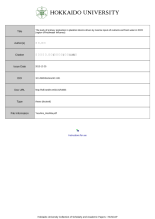The study of primary production in plankton blooms driven by riverine inputs of nutrients and fresh water in ROFI (region of freshwater influence) 河川影響海域での淡水と栄養塩の河川供給によるプランクトンブルーム基礎生産の考察
Access this Article
Author
Bibliographic Information
- Title
-
The study of primary production in plankton blooms driven by riverine inputs of nutrients and fresh water in ROFI (region of freshwater influence)
- Other Title
-
河川影響海域での淡水と栄養塩の河川供給によるプランクトンブルーム基礎生産の考察
- Author
-
干場, 康博
- University
-
北海道大学
- Types of degree
-
博士(環境科学)
- Grant ID
-
甲第11161号
- Degree year
-
2013-12-25
Note and Description
Rivers transport nutrients and suspended sediment matter (SSM) as well as fresh water from land to coastal regions, where the biological productivity is high. In the coastal area, the buoyancy of fresh water leads to the formation of horizontal anticyclonic gyres and vertical circulations, which affect the variation of biological production such as plankton blooms. However, the primary production caused by the three-dimensional dynamics have not been quantitatively discussed, and observations can hardly capture the daily temporal variations of phytoplankton blooms. We developed an ocean general circulation model (OGCM) including a simple ecosystem model, to investigate the three-dimensional and temporal changes in phytoplankton blooms caused by riverine input such as flooding.We first conducted ideal setting-simulations. The distribution patterns of nutrients and phytoplankton differ significantly from that of fresh water. The phytoplankton maxima shift from the downstream (right-hand side of the river mouth) to the upstream regions (left-hand side of the river mouth). The shift from the downstream to the upstream region (D-U Shift) is categorized by the different nitrate origins: (1) river-originated nitrate (RO-nitrate) is dominant in the downstream region; (2) subsurface-originated nitrate (SO-nitrate) is dominant in the upstream region, and is transported by upwelling associated with vertical circulation and horizontal anticyclonic gyre; and (3) regenerated nitrate (R-nitrate) is dominant in the upstream region. The total primary production in phytoplankton blooms is maintained not only by RO-nitrate but also by SO-nitrate that is 1.5 times larger than the river-originated. Next, we conducted the realistic simulation of Ishikari Bay and a few ideal setting-simulations. The phytoplankton maxima shift toward the left-hand side of the river mouth during the early time, but the shift does not keep going to the left-hand side all the time. This is because much SO-nitrate does not come from the subsurface to the surface layer after the middle simulated time, due to weak upwelling forced by vertical circulation in the left-hand side. The gentle angle of bottom slope weaken the vertical circulation and SO-nitrate supply from the subsurface, and the NPP is small.It is natural that D-U Shift of phytoplankton maxima often occurs in the real situation like Ishikari Bay when high riverine input such as flooding. The conclusion that the shift is categorized into three stages by the different nitrate origins, RO-, SO- and R- nitrates in turn depends on the bottom slope angle and the way of inputs and the amounts of fresh water and nutrients. Bottom slope angle and the way of fresh water input change the behaviour of plumes, nutrient supply from the subsurface with the change of vertical circulation, and the rate of regeneration.
(主査) 教授 山中 康裕, 教授 三寺 史夫, 准教授 西岡 純, グループ長 鬼塚 剛(瀬戸内海区水産研究所環境保全センター)
環境科学院(地球圏科学専攻)
